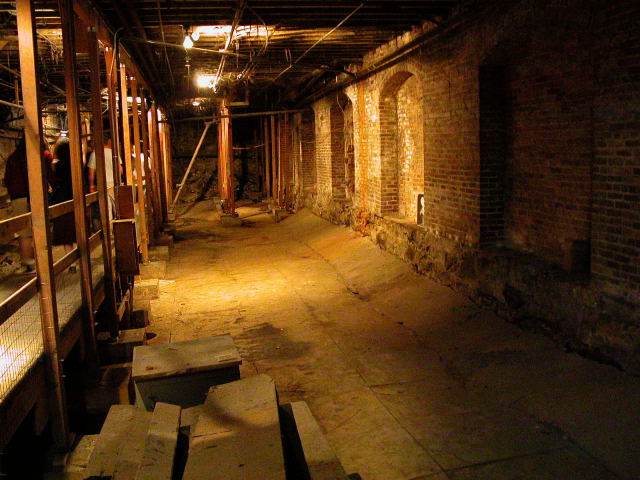The Shanghai Tunnels/Portland Underground
The Old Portland Underground, better known locally as the Shanghai tunnels, are a group of passages in Portland, mainly underneath Old Town/Chinatown and the Pearl District and connecting to the main business district, and beyond. Historically, the tunnels connected the basements of many hotels and taverns through brick and stone archways that intersected passageways under the streets, linking block to block, and creating access to the waterfront of the Willamette River. They were built to move goods from the ships docked on the Willamette to the basement storage areas, allowing businesses to avoid streetcar and train traffic on the streets when delivering their goods. These tunnels created a unique network of passages and thoroughfares that were used by unscrupulous individuals called "shanghaiiers”, who would grab individuals and sell them into slavery on outgoing sea vessels. Today, a small portion of this once-buried secret is one of the city’s tourist attractions for those with a taste for the macabre and outré. For those more familiar with the the layout of the tunnels beyond what the tourists are allowed to see, and for those who know the comings and goings of those who spend their time here, the tunnels are more familiarly known as the Undercity.
Despite the spooky reputation of the Shanghai Tunnels, a portion of it is now an electrically lit, thoroughly mapped tourist attraction; monstrous only in the amount of embellishment its corporately employed guides use in describing it to the very young, the very gullible, and out-of-towners. Thanks to them, stories of forgotten gem-filled bank vaults and assorted subterranean bogeymen hidden in haunted catacombs persist unabated.
Beyond the lighted, well-trodden areas of the tourist section of the Shanghai Tunnels, the Underground conceals some hazards. Rotted floors, collapsing ceilings, fetid water, vermin packs, fugitive criminals, violent lunatics, and more dangers all lie just past the souvenir stands. Areas as yet unexplored may hold even greater hazards and—as some brave, foolish folk insist— greater rewards. No matter how many go missing in the attempt, others continue to follow.
Few are aware the Shanghai Tunnels are not the whole of Portland's Underground. The Tunnels connects to various other underground structures and passages (some created in a failed early attempt at building a subway system during the early 20th century).
A diverse gathering of “underdwellers” inhabits these outlying areas. Some underdwellers simply reject surface life for their own nonconformist reasons, while others take refuge there in dire need, either for personal safety or evading the law. Some say a faction of of the Pantheon has a presence in the Undercity, as well as those associated with the liberation group known as The Freakshow that helps those with super powers that have so physically altered their physical appearance that they no longer appear human. Then there's also an offshoot of the city’s homeless community. While some are trapped there in the grip of their addictions or madness, others have simply grown accustomed to living off (and underneath) the grid. As with the other members of Portland’s “invisible residents,” they see and hear quite a bit, and can be great—if not always reliable—sources of information.
The Undercity appears to be deserted upon first inspection, but there are more beings living in it than is apparent to the new visitor. It’s true the denizens mostly keep to themselves in small, relatively safe, cordoned-off warrens, but these outcasts make up a fairly large community. A community that’s able to survive through salvage, theft, trade, and barter with the surface world and each other. The only way to get a clear sense of how large and diverse the population of the Underground is requires a visit to the Sunken Bazaar. It’s a mostly-permanent marketplace set up in the longest stretch of tunnel in the Underground. The Bazaar is about two city blocks long with a handful of alleys shooting off along its length. Merchants set up stalls, carts, or storefronts in the clogged thoroughfare to sell all manner of goods.
Like the rest of the Underground, the Sunken Bazaar is dark, dingy, and dangerous, although since most denizens require light to see, electric lights have been strung around to weakly illuminate the place. In addition, since the Bazaar has been in operation for decades, the walls and rafters have been reinforced to the point that it may be the safest place (structurally, at least) in the whole of the Shanghai Tunnels.
